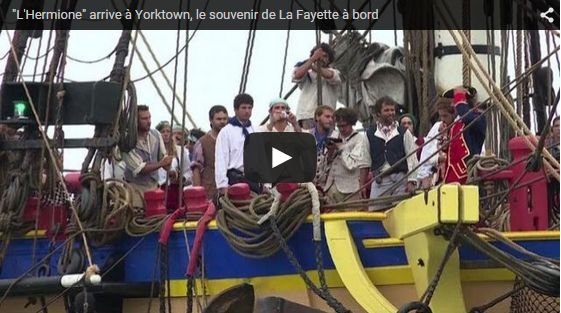In honor the summer solstice today, Summer Solstice by Moonlit Sailor, a Swedish post-rock instrumental group.
I remember when I was quite young, I asked the question, “Why is the ocean salty?” We had just visited my grandparents in Florida and I had discovered first hand just how salty the seawater in the Gulf of Mexico could be. I was told that salt dissolves in water and is carried to the oceans by rivers, so that over time the sea keeps getting saltier. It seemed like a good answer to me, so I moved on other questions.
Recently, however, I heard Robert Ballard, the famous oceanographer and underwater archaeologist of Titanic and Thresher fame, say that, until recently, oceanographers did not know why the ocean was salty. They didn’t know until 1979 to be exact. The problem is that the old explanation, that salt was carried in from the rivers, didn’t quite work. The chemistry of the oceans and the chemistry of the rivers were different enough to suggest that something else was going on. Here is Ballard explaining their discovery on National Geographic.

Model SS Cornubia
Today is Juneteeth, a commemoration of the abolition of slavery in the state of Texas, in particular, and in the Confederate states in general, one hundred and fifty years ago today.
On June 5, 1865, two Union Navy ships, USS Cornubia and USS Preston, steamed into Galveston harbor. Both ships had been captured from the Confederacy. USS Cornubia was a 210′ long British fast iron paddle steamer, purchased by Confederate agents as a blockade runner, renamed Lady Davis, and then captured by the Union Navy in 1863. USS Preston was a 170′ twin screw British blockade runner named Annie, captured in 1864. The ex-blockade runners carried Captain B. F. Sands with a detachment of Union troops to raise the United States flag over the federal customs house on the Texas island city. On June 18, 1865, Union General Gordon Granger arrived at Galveston Island with 2,000 federal troops and took full control.
 After five months, an abandoned catamaran has been sighted by a passing container ship. On January 30th of this year, Rainmaker, a brand new a $2.5 million carbon fiber Gunboat 55 catamaran, the first of its class, set off on a voyage from the Gunboat yard in North Carolina to St Martin in the Caribbean. Roughly 200 miles off the North Carolina coast, the boat dis-masted in a severe squall. The five crew were airlifted to safety by the Coast Guard and the boat was abandoned. Now five months later, the Hapag Lloyd container ship, Chicago Express, has spotted the derelict catamaran roughly 650 miles east of Cape Hatteras.
After five months, an abandoned catamaran has been sighted by a passing container ship. On January 30th of this year, Rainmaker, a brand new a $2.5 million carbon fiber Gunboat 55 catamaran, the first of its class, set off on a voyage from the Gunboat yard in North Carolina to St Martin in the Caribbean. Roughly 200 miles off the North Carolina coast, the boat dis-masted in a severe squall. The five crew were airlifted to safety by the Coast Guard and the boat was abandoned. Now five months later, the Hapag Lloyd container ship, Chicago Express, has spotted the derelict catamaran roughly 650 miles east of Cape Hatteras.
Sailing Anarchy reports that the container ship captain sent the following message:
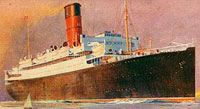 The tragic loss of an estimated 6,500 men, women and children on the Lancastria was covered up for more than seventy years. It was the greatest loss of life in the sinking of a single British ship, claiming more lives than the combined losses of the RMS Titanic and RMS Lusitania (1,200 passengers). Here is a repost from 2011, in honor of those lost on this day seventy five years ago. First posted October 2, 2011:
The tragic loss of an estimated 6,500 men, women and children on the Lancastria was covered up for more than seventy years. It was the greatest loss of life in the sinking of a single British ship, claiming more lives than the combined losses of the RMS Titanic and RMS Lusitania (1,200 passengers). Here is a repost from 2011, in honor of those lost on this day seventy five years ago. First posted October 2, 2011:
The evacuation of British troops and civilians from France in 1940 did not end with Dunkirk. Several weeks later, on June 17, 1940, the British Cunard liner Lancastria was loaded to capacity with troops and civilians off the French port of St. Nazaire, when she was struck by three direct hits from a German Junkers Ju 88 bomber. As many as 6,500 men, women, and children were lost when the ship sank. News of the disaster was covered up. Churchill said, “The newspapers have got quite enough disaster for today, at least.”
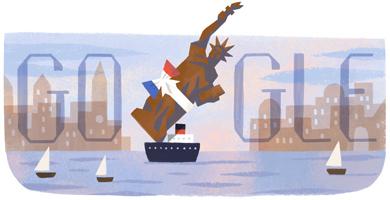 Today’s “Google Doodle,” the changing graphic that appears at the top of the Google search page, is a whimsical memorial to the arrival of the Statue of Liberty in New York. “Google is celebrating America’s most famous gift from France today with a logo marking the Statue of Liberty’s arrival in the New York Harbor 130 years ago on June 17, 1885.”
Today’s “Google Doodle,” the changing graphic that appears at the top of the Google search page, is a whimsical memorial to the arrival of the Statue of Liberty in New York. “Google is celebrating America’s most famous gift from France today with a logo marking the Statue of Liberty’s arrival in the New York Harbor 130 years ago on June 17, 1885.”
Many sources put the arrival of the Statue of Liberty in New York as two days later on the June 19th. Likewise, the Google Doodle takes artistic license in showing the Statue of Liberty teetering on the deck of a tiny generic steam ship. So when and how did the Statue of Liberty arrive in New York?

Luisa Jo Killen
Not quite two years so, we posted about the death of the British folk and shanty singer who as born as Louis Killen. The post title was “Lou Killen, British Folk Song and Shanty Singer, Dies at 79.” Now after the Olympic gold-medalist Bruce Jenner has emerged as Caitlyn Jenner, I wonder where it would have been more respectful and appropriate to title the post, “Louisa Jo Killen….” In the last years of his life Lou became Louisa Jo. I don’t usually go back and change posts, but in this case I have.
As we posted in 2013 : In 2010, at the age of 76, Killen surprised friends and fans alike when he began living openly as a woman, performing in women’s clothing and a wig. In 2012, he underwent a sex-change operation. As noted in the New York Times: Adopting the name Louisa Jo Killen, she continued to perform for almost two years, by most accounts winning over most of Louis Killen’s fans and all of his friends.
 Millions over budget and years behind schedule, the Canadian schooner Bluenose II finally set sail last week from Lunenberg, Nova Scotia on a training sail. Bluenose II is owned by the government of Nova Scotia and will serve as a sailing ambassador for the province. While notionally a restoration and repair of the schooner Bluenose II built in 1963, the schooner is essentially new construction with new a keel, frames and planking and more modern scantlings. Originally budgeted at $14 million, the final cost will be over $20 million and may rise further. A $5 million claim with the shipyard has yet to be adjudicated. The new schooner is a near replica of the famous Nova Scotia fishing schooner Bluenose, built in 1921, which won a series of fishing schooner races in the 1920s and 1930s. Images of the schooner Bluenose have appeared on a Canadian stamp as well as on the current Nova Scotia licence plate and on the Canadian dime.
Millions over budget and years behind schedule, the Canadian schooner Bluenose II finally set sail last week from Lunenberg, Nova Scotia on a training sail. Bluenose II is owned by the government of Nova Scotia and will serve as a sailing ambassador for the province. While notionally a restoration and repair of the schooner Bluenose II built in 1963, the schooner is essentially new construction with new a keel, frames and planking and more modern scantlings. Originally budgeted at $14 million, the final cost will be over $20 million and may rise further. A $5 million claim with the shipyard has yet to be adjudicated. The new schooner is a near replica of the famous Nova Scotia fishing schooner Bluenose, built in 1921, which won a series of fishing schooner races in the 1920s and 1930s. Images of the schooner Bluenose have appeared on a Canadian stamp as well as on the current Nova Scotia licence plate and on the Canadian dime.
Bluenose II raises sail as captain readies vessel for service
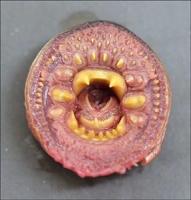
Arctic Lamprey, Yukon River near Kaltag. (Randy Brown/USFWS)
The headlines are great. CBS News reports: Terrifying “vampire fish” falling from the sky in Alaska. Huffington Post chimes in: Hellacious Eel-Like Fish Are Dropping From The Sky In Alaska. The Washington Post offered, Why these mysterious, blood-sucking fish fell from the Alaskan sky.
It seems that live arctic lampreys were found on shore in Fairbanks Alaska, having apparently fallen from the sky. A rain of live fish is strange enough, but lampreys, over a foot long, look like something out a horror movie. They have a sucker-like mouth with five rows of teeth which they use to attach themselves to larger fish and other marine animals.
How these strange fish happen to fall from the sky? Alaska Department of Fish and Game information officer Nancy Sisinyak says that gulls likely picked up the fish in the nearby Chena River and then dropped them from their mouths mid-flight over the town. “When the fish wiggles free, and the bill scrapes the gills off the fish, it leaves a V-shape on either side,” Sisinyak said.
And how may fish have fallen from the sky? A grand total of four lampreys have been found ashore so far.
The Russian Sail Training Ship Kruzenshtern was maneuvering to depart the old harbor in Reykjavík, Iceland, yesterday, when she rammed two of the largest Icelandic Coast Guard vessels, Týr and Thor. Both ships suffered damage, although well above the waterline. There are no reports on damage to the Kruzenshtern.
STV “Kruzenshtern” collision in Reykjavik
 Alaric Bond’s latest novel, The Scent of Corruption, the seventh in the Fighting Sail series, is now available on Kindle and will soon be available in print. A great read.
Alaric Bond’s latest novel, The Scent of Corruption, the seventh in the Fighting Sail series, is now available on Kindle and will soon be available in print. A great read.
About the novel: Summer, 1803: the uneasy peace with France is over, and Britain has once more been plunged into the turmoil of war. After a spell on the beach, Sir Richard Banks is appointed to HMS Prometheus, a seventy-four gun line-of-battleship which an eager Admiralty loses no time in ordering to sea. The ship is fresh from a major re-fit, but Banks has spent the last year with his wife and young family: will he prove himself worthy of such a powerful vessel, and can he rely on his officers to support him?
With excitement both aboard ship and ashore, gripping sea battles, a daring rescue and intense personal intrigue, The Scent of Corruption is a non-stop nautical thriller in the best traditions of the genre.
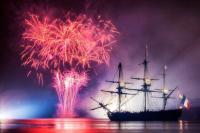 The French frigate l‘Hermione was greeted by a dramatic fireworks display on its arrival at Mount Vernon, Virginia, George Washington’s plantation home. In 1780, the original frigate L’Hermione, carried the 23 year old Gilbert du Motier, better known as the Marquis de Lafayette, to America with the secret news that France was committing 5,500 men and five frigates to help George Washington and his forces in the revolution against Great Britain. Over the course of the war, Washington and Lafayette developed a close relationship. It is often said that Washington saw in Lafayette the son he never had, which gave the arrival of Lafayette’s frigate at George Washington’s home at Mount Vernon a special significance. To see more of the photographs by NinjaPix, click here.
The French frigate l‘Hermione was greeted by a dramatic fireworks display on its arrival at Mount Vernon, Virginia, George Washington’s plantation home. In 1780, the original frigate L’Hermione, carried the 23 year old Gilbert du Motier, better known as the Marquis de Lafayette, to America with the secret news that France was committing 5,500 men and five frigates to help George Washington and his forces in the revolution against Great Britain. Over the course of the war, Washington and Lafayette developed a close relationship. It is often said that Washington saw in Lafayette the son he never had, which gave the arrival of Lafayette’s frigate at George Washington’s home at Mount Vernon a special significance. To see more of the photographs by NinjaPix, click here.

Photo: Billy Black
Toward the end of June, the 52′ yawl Dorade will be joining 40 other yachts to race 2,800 nautical miles in the Transatlantic Race 2015, which starts in Newport, R.I., and finishes off the southwestern coast of England. This is not the first time Dorade has competed in this race. In the 1939 Transatlantic Race, when the boat was just a year old, Dorade was the first boat to finish and the race’s overall champion on corrected time. This year, Dorade‘s owners, Pam Levy and Matt Brooksshe, will see if the grand old yacht can win it again.

It looked like a tsunami rolling in from the Atlantic toward the beach at Sea Girt on the Jersey Shore. Except that it wasn’t rolling in. It just hung there. It wasn’t a tsunami. It was merely a beautiful if somewhat threatening fog bank. The National Weather Service later released their own explanation of the fog.
 Happy World Oceans Day. June 8th has been celebrated, unofficially, as World Oceans Day since 1992, and has been officially recognized by the United Nations since 2008. This year the theme is “Healthy Oceans. Healthy Planet.”
Happy World Oceans Day. June 8th has been celebrated, unofficially, as World Oceans Day since 1992, and has been officially recognized by the United Nations since 2008. This year the theme is “Healthy Oceans. Healthy Planet.”
What does World Ocean Day mean, from a practical perspective? Probably not too much. It feels like another marketing campaign focused on “awareness” rather than substance or policy. Unfortunately, the sponsoring organization has not fully abandoned their past “Wear blue, tell two” campaign, where to celebrate WOD, you were directed to wear blue clothes and tell two friends or colleagues about the importance of the world’s oceans. One useful initiative this year is the “Better Bag Challenge” which recommends not accepting disposable plastic bags for a year. The “Challenge” is buried in a poorly coded, virtually graphics free web site, so I doubt many will see it in any case.
Sounds like great summer sailing on the brand new tall ship Oliver Hazard Perryfor kids from 13-18. There are one and two week programs in July and August. Click here to learn more.
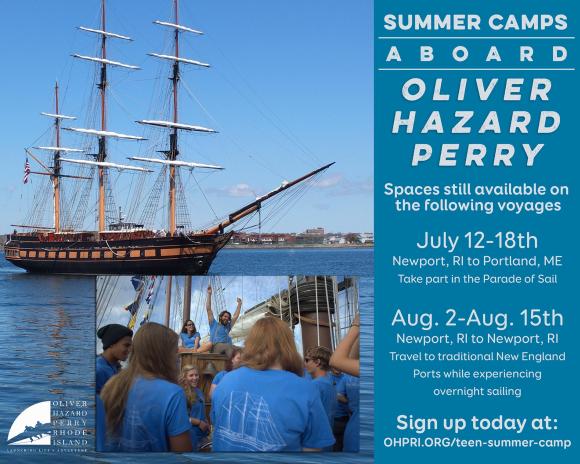
In 1780, the French frigate, l’Hermione carried the Marquis de Lafayette to America with the news of French support for the American revolution. Now a replica l’Hermione has arrived in Yorktown, VA, the first of twelve ports that the frigate will visit on her reeanctment of her namesake’s historic voyage.
l‘Hermione arrive à Yorktown, le souvenir de La Fayette à bord
 If you are near New York harbor, the Working Harbor Committee Hidden Harbor Tours® has two great new tours coming up — “Made in Brooklyn” on Thursday, June 11th, and a “Family Fun Day Boat Tour” on Saturday, June 20th.
If you are near New York harbor, the Working Harbor Committee Hidden Harbor Tours® has two great new tours coming up — “Made in Brooklyn” on Thursday, June 11th, and a “Family Fun Day Boat Tour” on Saturday, June 20th.
“Made in Brooklyn” — Join Working Harbor Committee for a tour of Brooklyn waterfront industry, past and present. From Newtown Creek through Sunset Park, the 8 miles of Brooklyn shore facing the Harbor’s Upper Bay were once filled with manufacturing, shipping, and commerce. Highlights include Brooklyn Navy Yard, the city’s new waterfront recycling facility at Gowanus Bay, and the working rail-to-barge connection at Brooklyn Army Terminal. The tour is narrated by Newtown Creek Alliance Historian Mitch Waxman and Captain Margaret Flanagan, Maritime Operations, Metropolitan Waterfront Alliance. The 2-hour boat tour departs at 6:00pm sharp. Boarding begins at 5:30pm. Click here for tickets.
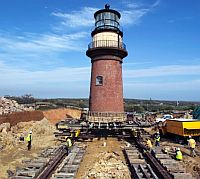 Recently, Gay Head lighthouse on Martha’s Vineyard, off the coast of Massachusetts, was very carefully jacked up and moved 135 feet inland, far enough away from the crumbling red clay cliffs of Gay Head to prevent it toppling into the ocean. The lighthouse should be reopened to the public by sometime in July. There has been a lighthouse on Gay Head since 1799. The current lighthouse dates from 1856. There is a video of the move after the page break.
Recently, Gay Head lighthouse on Martha’s Vineyard, off the coast of Massachusetts, was very carefully jacked up and moved 135 feet inland, far enough away from the crumbling red clay cliffs of Gay Head to prevent it toppling into the ocean. The lighthouse should be reopened to the public by sometime in July. There has been a lighthouse on Gay Head since 1799. The current lighthouse dates from 1856. There is a video of the move after the page break.
 Was MV Dong Fang Zhi Xing (Oriental Star) unsafe and unstable or was she just at the wrong place at the wrong time? Should the captain have anchored, as did several other ships on the river, when he received warning of bad weather, or would the ship have capsized at anchor or underway when hit by the tornado? As the Chinese come to terms with the greatest nautical tragedy in decades, there are far more questions than answers.
Was MV Dong Fang Zhi Xing (Oriental Star) unsafe and unstable or was she just at the wrong place at the wrong time? Should the captain have anchored, as did several other ships on the river, when he received warning of bad weather, or would the ship have capsized at anchor or underway when hit by the tornado? As the Chinese come to terms with the greatest nautical tragedy in decades, there are far more questions than answers.
The official Xinhua News Agency is reporting that only 14 had been rescued, and more than 70 confirmed dead, of the 458 aboard the ill-fated passenger ship that capsized in the Yangtze River on Monday night. The captain, Zhang Shunwen, along with the chief engineer, was one of the few survivors. He has been detained by the police for questioning.

